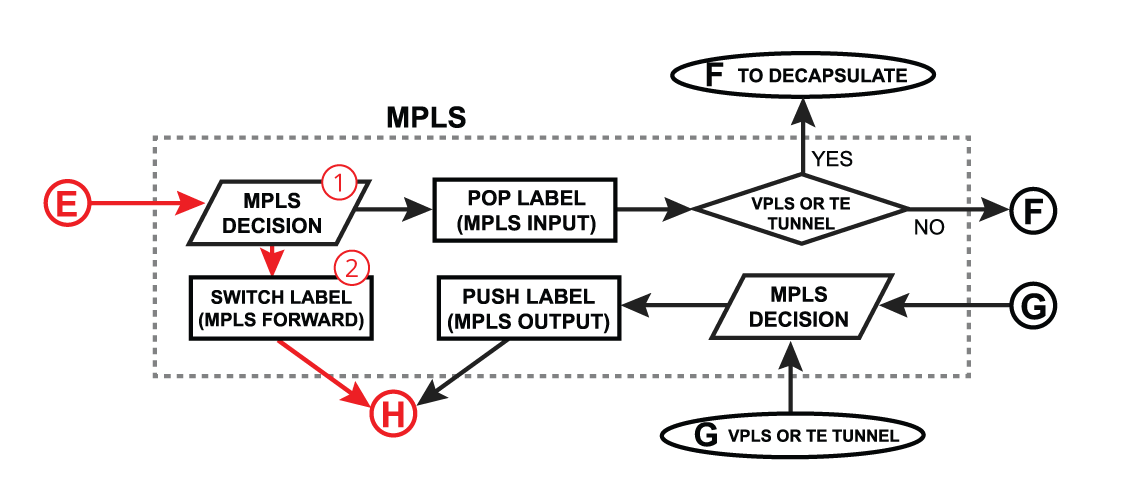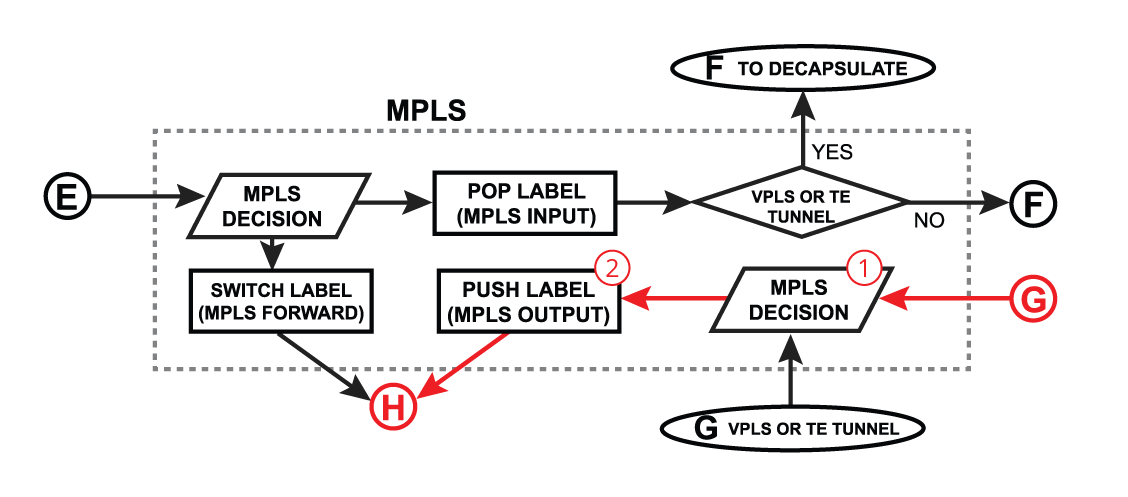...
- switching decision - widely depends on the switch model. This block controls all the switching-related tasks, like host learning, packet forwarding, filtering, rate-limiting, VLAN tagging/untagging, mirroring, etc. Certain switch configurations can alter the packet flow;
- switch-cpu port - a special purpose switch port for communication between the main CPU and other switch ports. Note that the switch-cpu port does not show up anywhere on RouterOS except for the switch menu, none of the software-related configurations (e.g. interface-list) can be applied to this port. Packets that reach the CPU are automatically associated with the physical in-interface.
The hardware offloading, however, does not restrict a device to only hardware limited features, rather it is possible to take advantage of the hardware and software processing at the same time. This does require a profound understanding of how packets travel through the switch chip and when exactly they are passed to the main CPU.
| Info |
|---|
Switch features found in the "/interface/ethernet/switch" menu and its sub-menus, like ACL rules, mirroring, ingress/egress rate limiters, QoS, and L3HW (except inter-VLAN routing) may not rely on bridge hardware offloading. Therefore, they can potentially be applied to interfaces not configured within a hardware-offloaded bridge. |
Switch Forward
We will further discuss a packet flow when bridge hardware offloading is enabled and a packet is forwarded between two switched ports on a single switch chip. This is the most common and also the simplest example:
...
| Section | ||
|---|---|---|
|
Push Label
| Section | ||
|---|---|---|
|
MPLS IP VPN
In VPNv4 setups packet arriving at PE router that needs to be forwarded to the CE router is not a typical "forward".
If incoming label and destination is bound to the VRF Then after MPLS label is popped and:
- destination address is local to the router, then packet is moved to LOCAL_IN
- destination address is in the CE network, then packet is moved to LOCAL_OUT
| Warning |
|---|
Forwarded packets from MPLS cloud to the CE network will not show up in the forward. |
For example traffic from src:111.15.0.1 to dst:111.13.0.1
| Code Block | ||
|---|---|---|
| ||
[admin@CCR2004_2XS] /mpls/forwarding-table> print
Flags: L - LDP, P - VPN
Columns: LABEL, VRF, PREFIX, NEXTHOPS
# LABEL VRF PREFIX NEXTHOPS
0 P 17 myVrf 111.13.0.0/24
4 L 20 main 203.0.113.2 { label=impl-null; nh=111.11.0.1; interface=sfp-sfpplus1 }
[admin@CCR2004_2XS] /mpls/forwarding-table>
...
[admin@CCR2004_2XS] /ip/route> print detail
Flags: D - dynamic; X - disabled, I - inactive, A - active; c - connect, s - static, r - rip, b - bgp, o - ospf, i - is-is, d - dhcp, v - vpn, m - modem, y - bgp-mpls-vpn;
H - hw-offloaded; + - ecmp
DAc dst-address=111.11.0.0/24 routing-table=main gateway=sfp-sfpplus1 immediate-gw=sfp-sfpplus1 distance=0 scope=10 suppress-hw-offload=no
local-address=111.11.0.2%sfp-sfpplus1
DAc dst-address=203.0.113.1/32 routing-table=main gateway=lo immediate-gw=lo distance=0 scope=10 suppress-hw-offload=no local-address=203.0.113.1%lo
DAo dst-address=203.0.113.2/32 routing-table=main gateway=111.11.0.1%sfp-sfpplus1 immediate-gw=111.11.0.1%sfp-sfpplus1 distance=110 scope=20 target-scope=10
suppress-hw-offload=no
DAc dst-address=111.13.0.0/24 routing-table=myVrf gateway=sfp-sfpplus2@myVrf immediate-gw=sfp-sfpplus2 distance=0 scope=10 suppress-hw-offload=no
local-address=111.13.0.2%sfp-sfpplus2@myVrf
DAy dst-address=111.15.0.0/24 routing-table=myVrf gateway=203.0.113.2 immediate-gw=111.11.0.1%sfp-sfpplus1 distance=200 scope=40 target-scope=30 suppress-hw-offload=no [admin@CCR2004_2XS] /ip/route> |
Packet will be seen in the output and postrouting chains, because now it is locally originated packet with source MAC address equal to vrfInterface:
| Code Block | ||
|---|---|---|
| ||
08:10:55 firewall,info output: in:(unknown 0) out:sfp-sfpplus2, connection-state:established src-mac f2:b5:e9:17:18:3b, proto ICMP (type 8, code 0), 111.15.0.1->111.13.0.1, len 56
08:10:55 firewall,info postrouting: in:myVrf out:sfp-sfpplus2, connection-state:established src-mac f2:b5:e9:17:18:3b, proto ICMP (type 8, code 0), 111.15.0.1->111.13.0.1, len 56 |
On the other hand, for packets routed in the direction CE→PE will be seen in the "forward" as any other routed IP traffic before being sent to the MPLS:
| Code Block | ||
|---|---|---|
| ||
08:10:55 firewall,info prerouting: in:sfp-sfpplus2 out:(unknown 0), connection-state:established src-mac dc:2c:6e:46:f8:93, proto ICMP (type 0, code 0), 111.13.0.1->111.15.0.1, len 56
08:10:55 firewall,info forward: in:sfp-sfpplus2 out:sfp-sfpplus1, connection-state:established src-mac dc:2c:6e:46:f8:93, proto ICMP (type 0, code 0), 111.13.0.1->111.15.0.1, len 56
08:10:55 firewall,info postrouting: in:sfp-sfpplus2 out:sfp-sfpplus1, connection-state:established src-mac dc:2c:6e:46:f8:93, proto ICMP (type 0, code 0), 111.13.0.1->111.15.0.1, len 56
|
But there can be an exception. If destination IP of reply packet is local to the router and connection tracking is performing NAT translation then connection tracking will "force" packet to move through the firewall prerouting/forward/postrouting chains.
Logical Interfaces
So far we looked at examples when in or out interfaces are actual physical interfaces (Ethernet, wireless), but how packets will flow if the router receives tunnel encapsulated packets?
...

